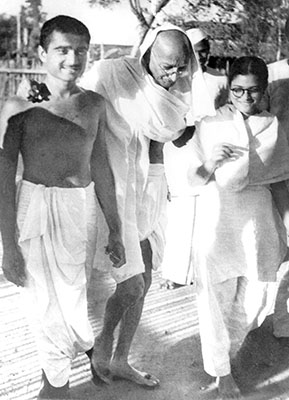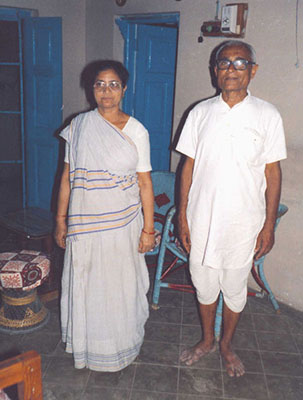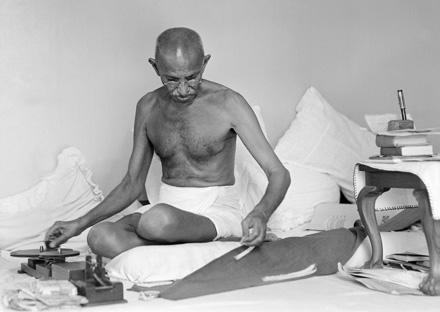
kanu gandhi
The core of the collection originates from Kanu Gandhi's estate (1917-1986), representing the majority of his studio's contents at his passing. Kanu, the second son of Narandas Gandhi (born 1885), was Mahatma Gandhi’s second cousin once removed (their common ancestors being Jivanchand Gandhi, born 1851, and Karamchand Gandhi, respectively). Narandas and his siblings, Chhaganlal and Maganlal, were close associates of Gandhi since his days in South Africa. Born into Gandhi's innermost circle, Kanu spent his childhood at the Sabarmati Ashram, managed by his father and established by Gandhi in 1917. His commitment to the independence movement was evident when, at 15, he was imprisoned for his involvement in the Non-Cooperation Movement of 1932.
Kanu joined Gandhi in 1935, leaving his father's side. By early 1936, Gandhi's correspondence frequently mentioned Kanu as a close personal aide. He played a significant role at the Sevagram Ashram in Wardha, Maharashtra, from its inception. Gandhi, along with his wife Kasturba, orchestrated Kanu's marriage to Abha, the daughter of devotee Amritlal Chatterjee, with the wedding taking place in 1944. The couple dedicated themselves to Gandhi's personal and professional needs. Kanu led prayers and managed Gandhi's belongings during travels, while Abha, referred to by Gandhi as one of his "walking sticks," supported him physically in his later years.
Reflecting on those times, Abha remembered Gandhi's words, “We are like three bodies but one soul.”


Throughout his years of dedicated service to Mahatma Gandhi, Kanu Gandhi took photographs that offer a uniquely intimate portrayal of the father of modern India. Encouraged by Shivaji Bhave, brother of Vinoba Bhave, and financially supported by Gandhi's industrialist friend Ghanshyam Das Birla, Kanu bought his first camera. As Gandhi's semi-official photographer, Kanu adhered to three conditions set by Gandhi: no posing, no flash photography, and no financial aid from Gandhi himself. The demand for Gandhi's photographs was so high that Kanu could fund his work through sales. His collection includes personal images of Gandhi at work, in conversation, and during his travels across India.
Abha was with Gandhi during his assassination in January 1948, but Kanu was not, as he had stayed in Noakhali to further Gandhi's mission of peace. Later, Kanu photographed Indian politicians, Gandhian activists like Vinoba Bhave, and the impact of the 1966-67 Bihar famine. His primary focus remained on preserving Gandhi's legacy, promoting khadi, and fostering small industries in Rajkot. Kanu Gandhi passed away from a heart attack in 1986, leaving behind a vast collection of photographs, later acquired from his heirs.

The Kanu Gandhi estate
The Kanu Gandhi photo collection showcases a variety of images depicting daily life at the Sevagram Ashram, with Gandhi involved in household tasks, conversing on the telephone, reading newspapers, or strolling around the ashram. It features him with animals and performing manual work, particularly spinning on both the charka (wheel) and the Dhanush Takli. The collection also captures less common ashram activities like leprosy research, with Gandhi examining leprosy bacteria under a microscope and giving massages to the Sanskrit scholar Parchure Shastri, a leprosy patient. Frequently, he is portrayed with other ashram residents, including Kasturba and extended family members. Abha Gandhi appears in numerous photos, often with Gandhi's granddaughter, Manu. Prominent associates like Mirabehn, secretaries Mahadev Desai and Pyarelal Nayyar, Pyarelal’s sister Sushila, and other relatives are also regular subjects. The collection includes images of Gandhi hosting Congress leaders at his ashram hut, such as Jawaharlal Nehru, Sarvepalli Radhakrishnan, Sarojini Naidu, Abul Kalam Maulana Azad, Vallabhbhai Patel, Rajkumari Amrit Kaur, and C. Rajagopalachari, as well as meetings with Muhammed Ali Jinnah.
Kanu documented Gandhi's extensive travels across India, capturing his visits to ashrams such as Mahila Ashram in Wardha, Rashtriyashala Ashram in Rajkot, and Khadi Pratisthan Ashram near Calcutta. A remarkable collection of photographs from Juhu Beach in Bombay and Birla House in New Delhi depict Gandhi's life in his later years, including moments after his assassination. Images of his train journeys, the vast crowds greeting him at each stop, and his efforts to raise funds for the Harijan cause are also part of this record. His travels ranged from meetings with Khan Abdul Gaffar Khan and the Khudai Khidmatgar in the North West Frontier Province to visits in riot-affected East Bengal. Although Kanu's coverage of Gandhi's imprisonment at the Aga Khan Palace in Pune from August 1942 to May 1944 is limited, photographs of Gandhi's subsequent visits to the graves of his wife and Mahadev Desai, who both passed away during their incarceration, are available.
While the collection predominantly features images of Gandhi's intimate daily moments, it also showcases his public persona: Gandhi is depicted speaking into a microphone at the 1940 Congress meeting in Ramgarh, Jharkhand, inaugurating the Kamla Nehru Memorial Hospital in Allahabad in 1941, addressing large gatherings in Bengal and Madras, and alongside Madan Mohan Malaviya at Banaras Hindu University in Varanasi. The collection is further enriched with a significant series of Vinoba Bhave's photographic portraits and several autographed photos, including one by Nehru and his daughter Indira. Additionally, Kanu Gandhi later produced various commercial memorabilia to mark Gandhi's birth centenary in 1969, such as prints of Gandhi's beaming portrait, postcards, and sets of ten reproductions from the collection.
While the entire collection of prints was produced by the photographer, barring a few modern prints identified as such in the inventory, they span a wide printing timeframe. A minor fraction of the primary Gandhi photograph series (approximately 50 prints) are vintage, believed to be printed soon after the photographs were captured. Additional vintage prints encompass five larger prints, nearly all Vinoba Bhave photographs, a set of photographs previously assembled in an album depicting a circa 1950 visit to Delhi, and a few other scattered images. The majority of the prints were created by Kanu Gandhi between the 1950s and 70s. Kanu Gandhi employed various rubber stamps, invaluable for dating the prints. The earliest stamp is a rectangular copyright mark from "Segaon Ashram," a designation used until around 1936 (fig. 1), later succeeded by an oval stamp from "Sevagram Ashram" (fig. 2).
The vintage prints commonly feature a small circular copyright stamp with Hindi text ("Copy Right Photo, Kanu Gandhi"), though it lacks a specified location (fig. 3). Many prints bear the stamp from Rashtriyashala in Rajkot, Kanu Gandhi's residence post-1956, and include his name as well as his marketing label "Gandhi Chitralaya". Various copyright stamps in Hindi and English emerged after 1956, with the circular English text stamp being the most prevalent (fig. 4).




Kanu Gandhi often applied this last copyright stamp (fig. 4) to earlier prints.
Kanu Gandhi's reference album of his collection of photographs of Mahatma Gandhi.
The respective captions: Original document in Gujarati - English translation
